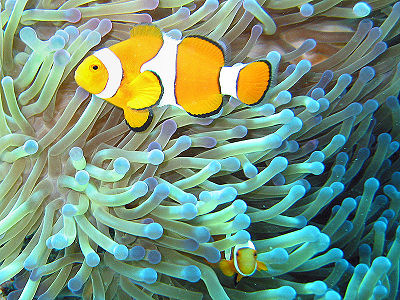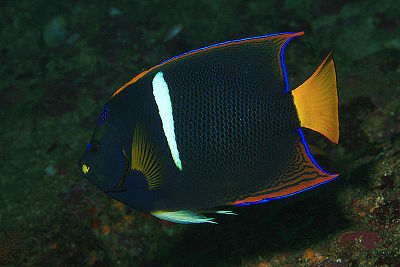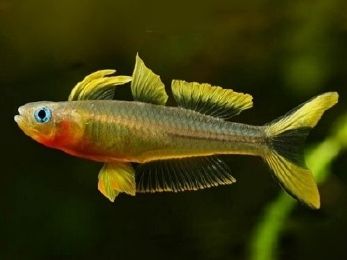
This fish can be called Ocellaris Clownfish, Common or False Percula Clownfish. Males grow to about 2.75 in., females to 4.3 in. Damsels may be territorial. Minimum size tank 25 gal. They are found in the Eastern Indian Ocean and the Tropical Pacific and is similar to the Percula Clownfish.
This fish is both easy to find and easy to care for. It eats all kinds of live, frozen, and flake foods. It is best to feed it small amounts several times a day. They can be territorial, especially as they get older.
Clownfish were made famous by the movie Finding Nemo, whose creator was inspired by a picture of two clownfish peeking out of an anemone. Andrew Stanton knew he wanted to make a movie whose main characters were fish, so he looked through books until he found the clownfish. He told National Geographic, “It was so arresting. I had no idea what kind of fish they were, but I couldn’t take my eyes off them. And as an entertainer, the fact that they were called clownfish—it was perfect. There’s almost nothing more appealing than these little fish that want to play peekaboo with you.”
In Finding Nemo, the main character, Nemo, is flushed down the toilet and returns to the wild. Many people believe this is an acceptable way to dispose of fish, but in reality fish flushed down the toilet are immediately killed. After the film was released, clownfish became an extremely popular pet, but unfortunately many of these new fish owners did not research the requirements for raising these fish. Because clownfish are salt water fish, they need different equipment from fresh water fish.
Sadly, clownfish have not been found to be any funnier than other fish.
Video
- Andaman Damselfish
- Arabian (Orange) Dottyback
- Asful (Arabian) Angelfish
- Australian Anemonefish
- Bandit Angelfish
- Banggai Cardinalfish
- Blackcap Gramma
- Blackedged Swallowtail
- Blue-green Chromis
- Blue Damselfish
- Blue Reef Chromis
- Blueface Angelfish
- Bluestreak Cleaner Wrasse
- Burgess Butterflyfish
- Candyline Basslet
- Carpenter’s Flasher Wrasse
- Catfish
- Cherub (Pygmy) Angelfish
- Clarke’s Anemonefish
- Cream Angelfish
- Domino Damselfish
- Dwarf Angelfish
- Eightline Wrasse
- Emperor Angelfish
- Fijian Blue and Gold Damselfish
- Fireball Dwarf Angelfish
- Flagfin (Threespot) Angelfish
- Flame Dottyback
- French Angelfish
- Golden Angelfish
- Golden Forktail
- Goldfish
- Goldflake Angelfish
- Hawaiian Spotted Pufferfish
- Humbug Aruanus
- Iridis Wrasse
- Kole (yellow-eyed) Tang
- Lamarck Angelfish
- Lemonpeel Dwarf Angelfish
- Leopard Wrasse
- Majestic Angelfish
- Maldive Anemonefish
- Maldive Velvet Fairy Wrasse
- Maroon Anemonefish
- Milletseed Butterflyfish
- Orange Skunk Anemonefish
- Ornate Swallowtail Angelfish
- Pacific Fire Anemonefish
- Pacific Pearlscale Butterflyfish
- Pajama (sixline) Wrasse
- Pajama Cardinalfish
- Passer (King) Angelfish
- Percula Clownfish
- Pink Skunk Anemonefish
- Potter’s Dwarf Angelfish
- Queen Angelfish
- Queensland Angelfish
- Queensland Dottyback
- Red Blotched Perchlet
- Red Candystripe Hogfish
- Red Sea Anemonefish
- Red Stripe Dwarf Angelfish
- Regal Angelfish
- Rock Beauty
- Royal Gramma
- Scribbled Angelfish
- Semicircle Angelfish
- Sharpnosed Possum Wrasse
- Skunk Tilefish
- Spotband Butterflyfish
- Spotted Coral Croucher
- Sunburst Butterflyfish
- Swissguard Basslet
- Tomato Anemonefish
- Tomini Bristletooth Tang
- Valentini Pufferfish
- Vermiculated Angelfish
- Yellow-tailed Blue Damselfish
- Yellow Swallowtail Angelfish


